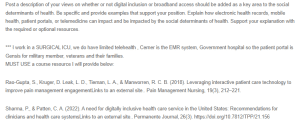Social Determinants of Health – Digital Inclusion and Broadband Access
As noted by the Centers for Disease Control and Prevention (CDC) (2022), social determinants of health (SDOH) are factors in patients’ lives other than clinical treatment that affect their health. Healthy People 2030 identifies five key areas: healthcare, education, social characteristics, economic resources, and the physical environment of the neighborhood. Due to a growing focus on digital health, digital equity or adequate broadband should be included in the SDOH.
Digital Inclusion and Healthcare
Digital inclusion refers to a state whereby everyone can participate and access information communication technologies. High-speed internet is required as it supports EHR, telemedicine, mHealth applications, and patient portals (Haleem et al., 2021). In the context of a surgical ICU environment, where the EMR system is Cerner and the patient portal for military members and veterans in Genesis, digital inclusion is necessary. Broadband is critical for improving healthcare experiences and outcomes since it provides dependable connections.
Addressing Disparities
Sharma and Patten (2022) point out that digital equity in healthcare has become a concern in the United States because digital divides can lead to health disparities. Those without broadband access may be unable to use telemedicine and are thus denied early treatment, especially for individuals with mobility problems or living far from a medical facility. Engagement in health management using digital tools can enhance patient interactions and related results (Rao-Gupta et al., 2018). Their work regarding pain management revealed that interactive patient care technology helps to improve patient engagement and thus increases the management of pain.
Enhancing Healthcare Delivery
Integrating digital inclusion as a core SDOH recognizes the critical use of digital solutions in today’s practice (Sieck et al., 2021). It deals with the challenges of locking out digital health tools that are crucial in the delivery of healthcare services. For instance, telemedicine provides consultation and follow-ups that would otherwise be impossible because of geographical barriers. Electronic health records and patients’ accounts, such as Genesis, offer essential information that patients can easily access and actively engage in managing their health.
References
Centers for Disease Control and Prevention. (2022, December 8). Social determinants of health. Centers for Disease Control and Prevention. https://www.cdc.gov/about/sdoh/index.html
Haleem, A., Javaid, M., Singh, R. P., & Suman, R. (2021). Telemedicine for healthcare: Capabilities, features, barriers, and applications. Sensors International, 2(2). NCBI. https://doi.org/10.1016/j.sintl.2021.100117
Rao-Gupta, S., Kruger, D., Leak, L. D., Tieman, L. A., & Manworren, R. C. B. (2018). Leveraging interactive patient care technology to improve pain management engagement. Pain Management Nursing, 19(3), 212–221. https://doi.org/10.1016/j.pmn.2017.11.002
Sharma, P., & Patten, C. A. (2022). A need for digitally inclusive health care service in the United States: Recommendations for clinicians and health care systems. The Permanente Journal, 26(3), 149–153. https://doi.org/10.7812/tpp/21.156
Sieck, C. J., Sheon, A., Ancker, J. S., Castek, J., Callahan, B., & Siefer, A. (2021). Digital inclusion as a social determinant of health. NPJ Digital Medicine, 4(1). https://doi.org/10.1038/s41746-021-00413-8
ORDER A PLAGIARISM-FREE PAPER HERE
We’ll write everything from scratch
Question
Post a description of your views on whether or not digital inclusion or broadband access should be added as a key area to the social determinants of health. Be specific and provide examples that support your position. Explain how electronic health records, mobile health, patient portals, or telemedicine can impact and be impacted by the social determinants of health. Support your explanation with the required or optional resources.

Social Determinants of Health
*** I work in a SURGICAL ICU, we do have limited telehealth, Cerner is the EMR system, a Government hospital, so the patient portal is Genesis for military member, veterans and their families.
MUST USE a course resource I will provide below:
Rao-Gupta, S., Kruger, D. Leak, L. D., Tieman, L. A., & Manworren, R. C. B. (2018). Leveraging interactive patient care technology to improve pain management engagementLinks to an external site.. Pain Management Nursing, 19(3), 212–221.
Sharma, P., & Patten, C. A. (2022). A need for digitally inclusive health care service in the United States: Recommendations for clinicians and health care systemsLinks to an external site.. Permanente Journal, 26(3). https://doi.org/10.7812/TPP/21.156

